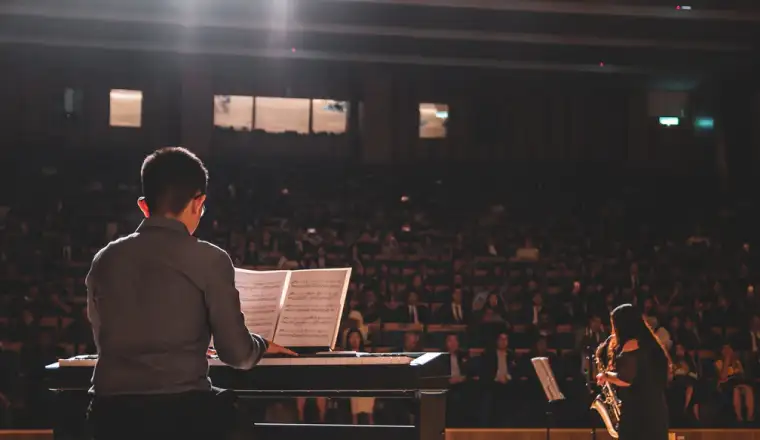Beijing Treaty on Audiovisual Performances

Table of Contents
A visual image communicates a thousand words, and copyright laws protect words. Yet, what does the law actually do for artists who relay messages through audiovisual recordings of their performances? Quick answer: apparently, not much—at least not until 2012 when international forces first created a global treaty to accommodate the audiovisual performers' rights. Nearly two decades after its conception, the 30th country – and, therefore, the final contracting state required to sign before entry into force – ratified the Beijing Treaty on Audiovisual Performances (BTAP). This article explores the movement of intellectual property rights for actors through time; the key features of the convention; and, looking forward, what it means for performers.
“It’s simple fairness. Passage of this treaty will extend to actors and other audiovisual performers crucial compensation, and image and likeness protections that have long existed for performers in sound recordings.” – Meryl Streep, Actor.
Casting Light on Your Rights
Before delving deeper into the transformation of intellectual property rights for performers across recent history, let us first set the stage for the conversation by introducing the relevant rights accorded to audiovisual performances:
- Copyrights – are intellectual property rights granted for creators of unique creative expressions so that they enjoy the exclusive right to publish or produce “copies” of their work.
- Neighbouring Rights – confer rights to parties related to the production, execution, and distribution of copyrighted materials. The recently acceded BTAP broadened these rights by codifying other liberties for performers.
A Brief History of the Performer’s Rights
The importance of intellectual property in the global economy and our society at large was highlighted in several giant leaps in world conventions. Official agreements came into effect as early as 1421 when the first modern patent was granted for an Italian inventor. However, evidence of similar rights, albeit not yet codified, dates as far back as 6th century BCE.
With this in mind, it would be easy to think that all rights were created equal. But this is far from the case. Industrially beneficial inventions were the first to receive intellectual property protection. Next came the provisions for written work. And, it was only 550 years after the first industrial patent that the performing arts were granted international recognition through the 1961 Rome Convention for the Protection of Performers, Producers of Phonograms and Broadcasting Organisations. But even then, their rights were tangential, at best.
In 1996, the convention was updated to include audio performances through the WIPO Phonograms and Performances Treaty (WPPT). Record labels, singers, and other audio performers began seeing their upscaled rights materialise. However, audiovisual media faced more vigorous opposition as producers initially refused to confer more rights to the actors.
Despite the global prominence of the audiovisual industry, as illustrated by the billion-dollars-worth Hollywood production companies, it is surprising that the actors’ rights were codified only within the past decade.
The Performer’s Economic Rights
Economic rights refer to the artists’ legal capacity to benefit financially from their performance. In contrast to the prior practice wherein producers are granted the bulk of the economic benefits of audiovisual executions, BTAP allows the performers to enjoy four fundamental rights for recorded performances:
- Right of Reproduction – pertains to the performer’s ability to authorise direct and indirect any form of reproduction for their audiovisual fixation.
- Right of Distribution – refers to the right to authorise the sale or transfer of ownership of the performance in audiovisual format.
- Right of Rental – is the right to allow commercial rental of the performance.
- Right of Making Available – is a specific provision to address the advancements in digital technology. This right allows performers to authorise online posting and other video-on-demand options.
For unfixed or live performances, artists are granted three kinds of rights:
- Right of Broadcasting – refers to the performers’ right to authorise non-interactive delivery or recorded performance for public reception.
- Right of Communication to the Public – covers any other means of public transmission.
- Right of Fixation – this pertains to the right to fix a performance to an audiovisual format.
These exclusive rights allow artists to allow or prohibit recording, broadcasting, and distribution of their audiovisual performances for a duration of 50 years since initial fixation.
Moreover, statutory licences offer solutions to deal with mass usage and private use. In cases where it would be impractical to seek individual authorisation for large-scale distribution, artists are entitled to receive equitable remuneration from their management. With respect to private use, artists benefit from levies on recording equipment and blank media storage.
The Performer’s Moral Rights
On the other hand, another significant leap in BTAP is the actors’ codified moral intellectual property rights. In substance, moral rights enable artists to uphold their reputation during the course of execution, fixation, broadcasting, and distribution of their performances. Specifically, there are two primary components of these rights:
- Right of paternity – refers to the artists’ right to be named, or not, as the performer of an audiovisual work.
- Right of integrity – is the right to oppose alterations which they deem prejudicial to the performer’s reputation.
Furthermore, it is essential to note that the above-mentioned moral rights remain independent of economic liberties. This means that they stay with the performer, even extending to representatives after the artist’s death, despite the previous transfer of some or all of the economic legal benefits. And although the duration of their rights after death vary in different jurisdictions, these moral rights are non-transferable across the board.
The Governments’ Responsibilities
While the BTAP successfully outlined the explicit provisions specific to the audiovisual industry, the implementation of such rights still heavily depends on government forces. Therefore, the treaty clarifies the instruments which legal bodies may use to streamline audiovisual rights across contracting parties.
The participating countries often employ the principle of reciprocity. Through this process, foreign performers from a member jurisdiction could enjoy the rights conferred to the local artists as long as the agreement remains mutual. For cases where no prior rights exist for local performers, the international provisions cover their rights.


Why Is This Important for You?
First and foremost, having a solid background on your rights would enable you to navigate the industry without the danger of unfair treatment and even illegal exploitation. BTAP activates your voice to authorise or decline public consumption while financially benefiting from your work.
As opposed to the common practice of automatic transfer of rights to the producers, artists nowadays have some level of control over their productions.
Moving forward, this provides a valuable resource for the audiovisual industry to know whether their country of origin complies with the international treaty. If, for instance, their performances are made available abroad, knowing the prevailing rights in that country could also inform possible claims for royalties. However, in case the local laws do not comply with BTAP, knowing that it exists globally would position unions and relevant organisations to lobby for the accession of the treaty.
Finally, BTAP’s entry into force is a symbolic achievement both for the intellectual property and audiovisual industries. Centuries after the world started placing an economic value on the arts; this is a step towards equalising the different fields of artistic expression.
Learn More on Intellectual Property
Are you a performer working with production or broadcasting studios? Or an independent artist licensing distribution to other companies? Perhaps you are an art enthusiast looking to venture into the world of audiovisual content creation in YouTube or other platforms?
Whichever of the above you are, or even if you are led here by your curiosity about intellectual property rights, there are a lot more insights you can use in your pursuit. If you are searching for bespoke solutions to your specific needs, our team of experts can guide you through the intricacies of copyrights and its neighbouring rights. You can take advantage of our complimentary consultation by dropping us a line at [email protected].
Frequently Asked Questions
What is the Beijing Treaty on Audiovisual Performances (BTAP)?
The BTAP is an international treaty that grants audiovisual performers rights and protections for their performances on a global scale.
When was the BTAP ratified?
The BTAP was ratified by the 30th country in 2012, marking its entry into force and providing comprehensive rights to audiovisual performers.
What rights does the BTAP provide to audiovisual performers?
The BTAP provides economic rights, including reproduction, distribution, rental, and making available, along with moral rights such as paternity and integrity.
How long do the exclusive rights last under the BTAP?
The exclusive rights granted to artists for their audiovisual performances last for a duration of 50 years from the initial fixation.
What are the moral rights conferred by the BTAP?
Moral rights include the right of paternity (naming as the performer) and the right of integrity (opposing prejudicial alterations), providing artists control over their reputation.
Can moral rights be transferred or inherited?
No, moral rights under the BTAP are non-transferable and extend even after the artist's death, ensuring the protection of their reputation.
How are the BTAP rights implemented?
The implementation of BTAP rights depends on government actions, often employing the principle of reciprocity, allowing foreign performers to enjoy local rights and vice versa.
Why is the BTAP important for performers?
The BTAP empowers performers by granting them control over their work, allowing them to authorize or decline public consumption and financially benefit from their performances.
How does the BTAP impact the audiovisual industry globally?
The BTAP serves as a global standard for audiovisual rights, equalizing different fields of artistic expression and providing a framework for fair treatment of performers.
How can performers ensure their rights under the BTAP?
Performers should be aware of their rights under the BTAP, navigate the industry with this knowledge, and, if needed, leverage local laws and international provisions to protect their interests.






